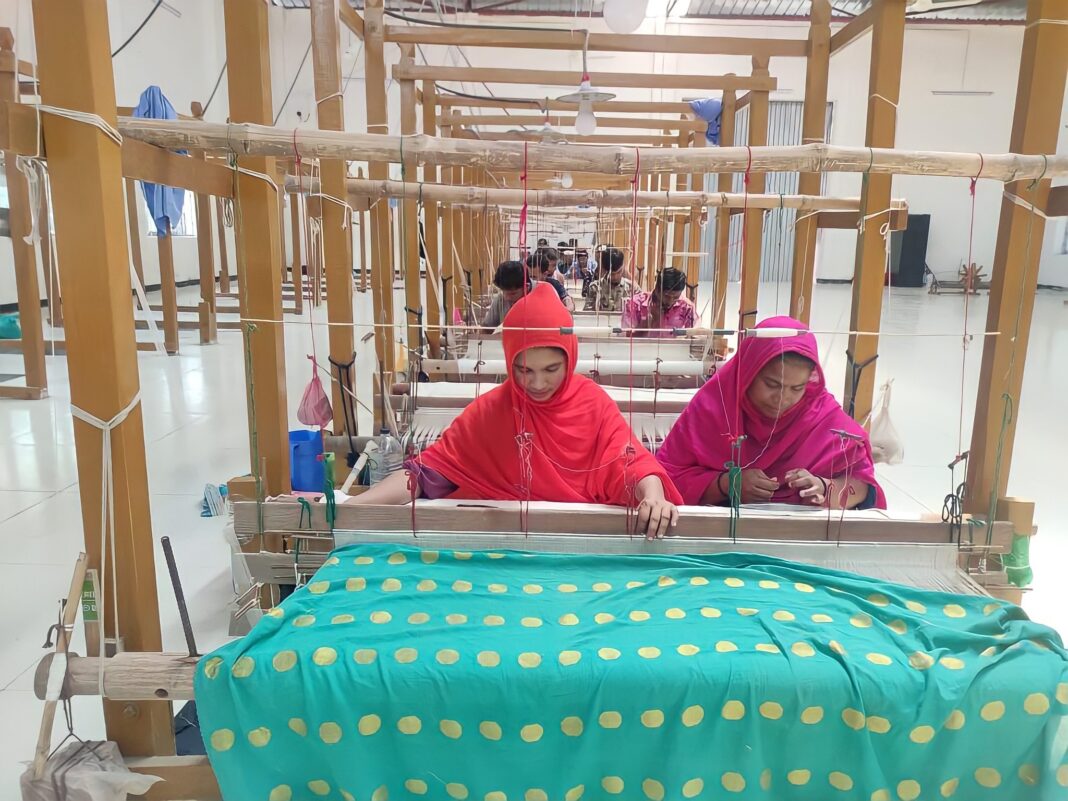DHAKA: Dhaka muslin, a fabric so light and fine that poets have described it as “woven air,” is poised for a rebirth in Bangladesh after years of research to revive long-lost production techniques.
The delicate cloth derives its name from the city of Mosul, now in Iraq, where it was first manufactured in the Middle Ages.
The fabric became popular in the Indian subcontinent under Mughal rulers, and from the 17th century production was centered in Dhaka, where weavers developed the cloth to its finest form, soon exporting it to the far corners of the world.
Dhaka muslin dominated the global market for 200 years. International royalty were among those who favored the fabric until it all but vanished in the early 20th century, phased out by machine-made alternatives and high import tariffs in Europe.
The complex technique required to make the fine handwoven cloth, which has thread counts ranging from several hundred to over 1,000, as well as knowledge of which cotton types were suitable for production, disappeared along with a generation of weavers who abandoned the craft.
Once the pride of the region, Dhaka muslin was forgotten for decades. Five years ago, however, researchers from the Bangladesh Handloom Board set out to revive the fabric. But it was not an easy task.
“We didn’t have any authentic samples to hand,” Mohammad Ayub Ali, who leads the project, told Arab News.
“But we didn’t give up. All of us nurtured a firm determination in mind to restore the secret.”
Ali’s team traveled to India, Egypt and the UK to find original samples of the historic fabric, and eventually relied on a version found in the Victoria & Albert Museum in London.
To determine the cotton species used by the old weavers of Dhaka, researchers turned to “Species Plantarum,” the groundbreaking book published by the Swedish botanist Carl Linnaeus in 1753, which listed every species of plant known at the time.
The plant was thought to be Phuti carpus, which researchers feared was now extinct.
“We prepared a morphological sketch of Phuti carpus and searched across the country to find if any sample of this cotton still existed,” Ali said. “Thirty-nine species of cotton samples were collected in this process.”
DNA testing, which matched the samples with muslin thread from the London museum, found that one plant, collected in the Kapasia region of Gazipur district, north of Dhaka, was almost 100 percent compatible.
To save it from extinction, the plant is now grown on experimental farms.
Prof. Mohammad Monzur Hossain, a University of Rajshahi botanist who led the search for Phuti carpus, said that the plant has features not found in other species.
“The fiber of this cotton has a high tensile strength compared with other cottons. And these fibers are short in length, which is convenient for hand spinning,” he told Arab News. “The muslin produced from Phuti carpus was so thin and transparent that it was called ‘woven air.'”
The “woven air” metaphor originated from classical Persian poetry — as did “flowing water,” “evening dew” and other terms. To bring these descriptions to life, however, proper skills and techniques were also essential.
Weavers taking part in the project were trained for over a year to use traditional wooden spinning wheels and hand-drawn looms to make fabrics with thread counts many times higher than what they were used to.
Higher thread counts — the number of crisscrossed threads per square inch — make materials softer and tend to wear better over time. The target was 500, but in the beginning the artisans could not go beyond 80.
Mohammad Rubel Mia learnt the craft as a child more than two decades ago and was accustomed to weaving delicate saris with thread counts around 100, but it took him a while to learn the muslin technique.
“Initially, it was not easy to deal with this almost microscopic thread,” he said. “We failed again and again.”
For Mohsena Akter, another worker at the Bangladesh Handloom Board’s Dhakai muslin project facility in Narayanganj, southwest of Dhaka, it is the most difficult task in her life.
The fabric is so fine that the fingers that weave it must always be soft.
“If our fingers get dry or become hard, we can’t deal with the delicate threads of muslin,” she said. “There is no time to lose focus, even for a fraction of a second, and it demands the highest level of perseverance.”
Fifteen spinners work for the Dhakai muslin project. It takes them 150 days to produce enough thread for just one piece of a muslin sari.
As they are preparing to enter the market, the project lead, Ali, said one muslin sari would cost an estimated $7,000 to $17,000, given the labor it takes to make it.
Hopes are high that the reborn historic fabric will be welcomed by the world’s fashion industry after an absence of almost 100 years.
“I believe it will also help in branding Bangladesh as the finest cloth-producing country,” Ali said. “We are considering taking in different fairs across the world.”




